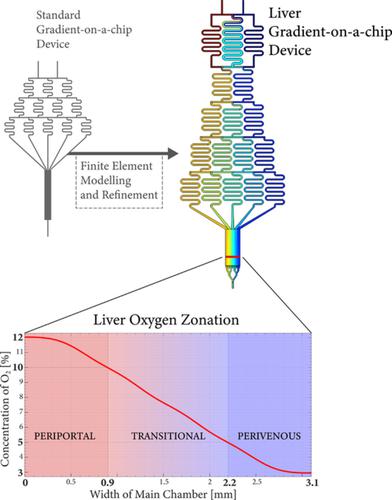当前位置:
X-MOL 学术
›
Int. J. Numer. Method. Biomed. Eng.
›
论文详情
Our official English website, www.x-mol.net, welcomes your feedback! (Note: you will need to create a separate account there.)
Modelling human liver microphysiology on a chip through a finite element based design approach
International Journal for Numerical Methods in Biomedical Engineering ( IF 2.1 ) Pub Date : 2021-01-31 , DOI: 10.1002/cnm.3445 Pedro Duarte Menezes 1 , Nikolaj Gadegaard 2 , Renato M Natal Jorge 1, 3 , Sónia I S Pinto 1, 3
International Journal for Numerical Methods in Biomedical Engineering ( IF 2.1 ) Pub Date : 2021-01-31 , DOI: 10.1002/cnm.3445 Pedro Duarte Menezes 1 , Nikolaj Gadegaard 2 , Renato M Natal Jorge 1, 3 , Sónia I S Pinto 1, 3
Affiliation

|
Organ‐on‐a‐chip (OoaC) are microfluidic devices capable of growing living tissue and replicate the intricate microenvironments of human organs in vitro, being heralded as having the potential to revolutionize biological research and healthcare by providing unprecedented control over fluid flow, relevant tissue to volume ratio, compatibility with high‐resolution content screening and a reduced footprint. Finite element modelling is proven to be an efficient approach to simulate the microenvironments of OoaC devices, and may be used to study the existing correlations between geometry and hydrodynamics, towards developing devices of greater accuracy. The present work aims to refine a steady‐state gradient generator for the development of a more relevant human liver model. For this purpose, the finite element method was used to simulate the device and predict which design settings, expressed by individual parameters, would better replicate in vitro the oxygen gradients found in vivo within the human liver acinus. To verify the model's predictive capabilities, two distinct examples were replicated from literature. Finite element analysis enabled obtaining an ideal solution, designated as liver gradient‐on‐a‐chip, characterised by a novel way to control gradient generation, from which it was possible to determine concentration values ranging between 3% and 12%, thus providing a precise correlation with in vivo oxygen zonation, comprised between 3%–5% and 10%–12% within respectively the perivenous and periportal zones of the human liver acinus. Shear stress was also determined to average the value of 0.037 Pa, and therefore meet the interval determined from literature to enhance liver tissue culture, comprised between 0.01 − 0.05 Pa.
中文翻译:

通过基于有限元的设计方法在芯片上模拟人体肝脏微生理学
片上器官 (OoaC) 是一种微流体装置,能够在体外培养活组织并复制人体器官复杂的微环境,通过对流体流动提供前所未有的控制,有望彻底改变生物研究和医疗保健,相关的组织体积比,与高分辨率内容筛选的兼容性和减少的占地面积。有限元建模被证明是一种模拟 OoaC 设备微环境的有效方法,可用于研究几何和流体动力学之间的现有相关性,以开发更准确的设备。目前的工作旨在改进稳态梯度发生器,以开发更相关的人类肝脏模型。以此目的,有限元方法用于模拟设备并预测哪些设计设置(由各个参数表示)可以更好地在体外复制人肝腺泡内在体内发现的氧梯度。为了验证模型的预测能力,从文献中复制了两个不同的例子。有限元分析能够获得理想的解决方案,称为肝梯度芯片,其特点是一种控制梯度生成的新方法,从中可以确定浓度值介于3%和12%,从而提供与体内氧分带的精确相关性,分别在人肝腺泡的静脉周围和门静脉周围区域内占 3%–5% 和 10%–12% 之间。剪切应力也被确定为平均0.037 Pa的值,因此满足从文献中确定的增强肝组织培养的区间,包括在0.01 - 0.05 Pa之间。
更新日期:2021-01-31
中文翻译:

通过基于有限元的设计方法在芯片上模拟人体肝脏微生理学
片上器官 (OoaC) 是一种微流体装置,能够在体外培养活组织并复制人体器官复杂的微环境,通过对流体流动提供前所未有的控制,有望彻底改变生物研究和医疗保健,相关的组织体积比,与高分辨率内容筛选的兼容性和减少的占地面积。有限元建模被证明是一种模拟 OoaC 设备微环境的有效方法,可用于研究几何和流体动力学之间的现有相关性,以开发更准确的设备。目前的工作旨在改进稳态梯度发生器,以开发更相关的人类肝脏模型。以此目的,有限元方法用于模拟设备并预测哪些设计设置(由各个参数表示)可以更好地在体外复制人肝腺泡内在体内发现的氧梯度。为了验证模型的预测能力,从文献中复制了两个不同的例子。有限元分析能够获得理想的解决方案,称为肝梯度芯片,其特点是一种控制梯度生成的新方法,从中可以确定浓度值介于3%和12%,从而提供与体内氧分带的精确相关性,分别在人肝腺泡的静脉周围和门静脉周围区域内占 3%–5% 和 10%–12% 之间。剪切应力也被确定为平均0.037 Pa的值,因此满足从文献中确定的增强肝组织培养的区间,包括在0.01 - 0.05 Pa之间。


























 京公网安备 11010802027423号
京公网安备 11010802027423号